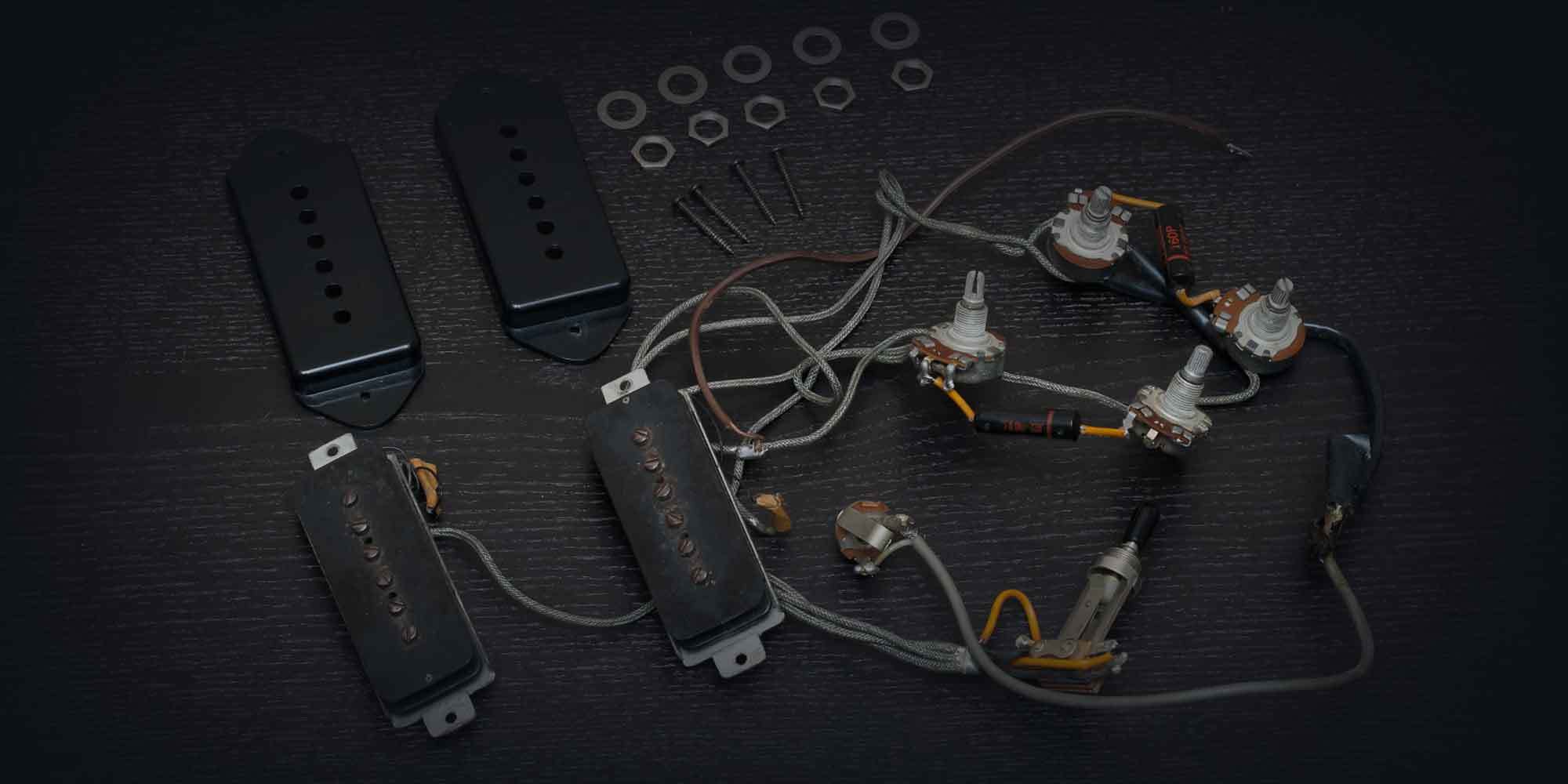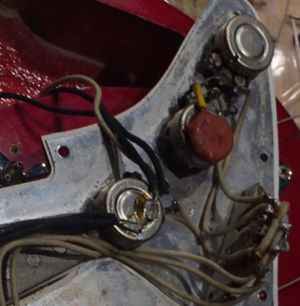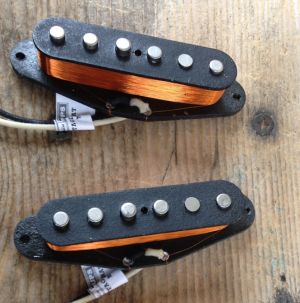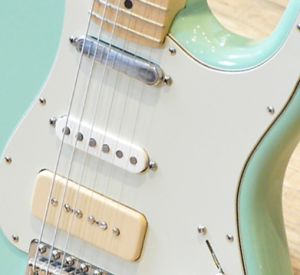
Pickups offer so much potential when looking to mod your electric guitar. They are relatively easy to replace, and from studying the specs of various models, you can have a reasonable expectation of the tone that you are going to achieve. However, buying used pickups is rarely so straightforward. You can look at pictures online, or hold a disconnected pickup in your hand, and really have no idea what it sounds like in your guitar.
To get a good set of tips on what to think about when buying used pickups, I interviewed two true experts: Lindy Fralin and Frank Falbo.
Lindy Fralin has been the leading name in boutique hand-wound pickups for years, matching classic sounds with modern reliability.
Frank Falbo currently consults for Fishman as a team member on the Fluence pickup project. Frank was also Product Vice President at Seymour Duncan and the brain behind the P-Rail pickup. Frank is the founder at Falbo Guitars, which have an amazingly innovative bridge design.
We focused our conversations around five central things to keep in mind when eyeballing a used pickup:
1. Wiring- How Do the Leads/Wires Look?

Both Lindy and Frank alleviated concerns over how much wire is remaining. Both mentioned that new extensions can be added to humbuckers without a real change in tone. Frank also noted that if you are installing a bridge pickup, many times a short amount of wire is all you need. Frank also stated that if you are not using a coil tap wire on a humbucker, you can even remove it or not use it in your install. Frank also says you can extend single coils with longer wires, but it is a more delicate operation. You can also ground wires to a location closer to the amount of wire you have remaining. Lindy notes that new wires do devalue a pickup, so be aware if buying for vintage restoration.
2. Damage to the Pole Pieces: What is Wear, What is Damage?
Lindy and Frank say that some corrosion on humbuckers is normal wear, but be on the look out for more extensive damage. A much corroded pole piece on a humbucker can indicate that there could be a bad ground connection, causing noise. Lindy states that corrosion can happen in a pickup from the inside out, and this is especially troublesome on a single coil, where the pole piece is the magnet, and can’t be repaired. Single coil pole pieces are less prone to rust notes Frank, but damage to a single coil is more debilitating notes Lindy. Also, always look for damage on the underside of the pickup and where the windings connect to the base.
3. Windings- What to Look For?

Windings are the heart of your pickup, if they are damaged, your pickup is dead. Frank recommends not inspecting the windings if it is difficult to do so, the tape protecting the pickup can do real damage if it is removed. If you can see the windings, Lindy and Frank say look out for dents, loose wires, and scratches. Scratches may seem not much of a worry, but Frank and Lindy both note that scratches in the insulation of the wire will cause shorts, which will kill the pickup. Even though these wires are very small, they are insulated, and once this small layer of protection is damaged, it cannot be fixed. Lindy notes that older Gibson pickups were wound in acid free tape, which has allowed them to age well, where other companies, such as Hofner, used tape that has degraded over time, causing the pickups to fail.
4. What's the Best Way to Test Overall Function if Installation in a Guitar is Not Possible (Such As Buying Online)?
Frank says that all sellers should supply you with a DC reading and that you should compare that to that to posted manufacturers specs. Frank also notes that the DC rating depends on the temperature in the room and of the pickup, so have the seller take the reading a few times. Frank says to remember that some companies have different tolerances variations in manufacture, so there will be some variation in every pickup.
Once you get the pickup in hand, inspect it for anything out of the ordinary, or any of the cautions listed above. To do a quick function test, touch the pickup wires directly to a cord plugged into an amp. With one wire on the tip and the other on the cord shaft, you will here the pickup, and can test each pole piece. Frank says to remember that the outside “E’s” might not be as loud as the others, as there is less contact to the magnet.
5. What Are Some Good Things to Keep in Mind About the Pickup as a Whole?

On the technical side, Frank noted that if you are not completely happy with the pickup, not all is lost. If you have an output issue, magnets can be finessed a bit. Ceramic magnets are less prone to damage, however alnico can degrade and demagnetize much easier. Frank says that magnets can be replaced in humbuckers and most magnets can be “recharged” (remagnatized) if they have lost strength. This can give a bit more “power” to your initial purchase. Frank also says to check polarity, and that single coils should attract to cancel hum if you are installing in a Strat-like fashion. Mounting brackets that have been modified can sometimes be bent back, sometimes not, so be careful when inspecting or installing. Also a tinnerman nut can be used to fix a stripped height adjustment screw hole or can undo a direct/hard mount installation.
Frank and Lindy also warned about counterfeit pickups, but on different ends of the spectrum. Frank said that many times OEM pickups pulled out of guitars may look different than one bought direct from the manufacturer. Sometimes manufactures want different ascetics, such as different pole pieces, covers, and colors of hardware or bobbins. This means that the pickup may not be a counterfeit, but will look slightly different from the standard production model. Research your specs and ask the seller for detailed provenance information if you think you might have this issue. Lindy also says to make sure you have proper documentation, as many times his pickups have been counterfeited.
Lindy also had a great adage to keep in mind when thinking about output: “More power, more forgiving. Weaker, more touch and dynamics, less forgiving”. Something to keep in mind when looking for more output, it might not equal more tone!
Frank’s parting message was that specs change with all manufacturers over time, so be aware of changes. He states that a few of his “holy grail” pickups are 70s Seymour Duncan JBs and early 90s Fender 57/62 sets.
A final bit of advice from both: ask your seller about a return policy. It will make things easier in the end.
Thanks to both Lindy and Frank for their time and advice!
What thoughts do you have on buying used pickups?
Guitar Pickups